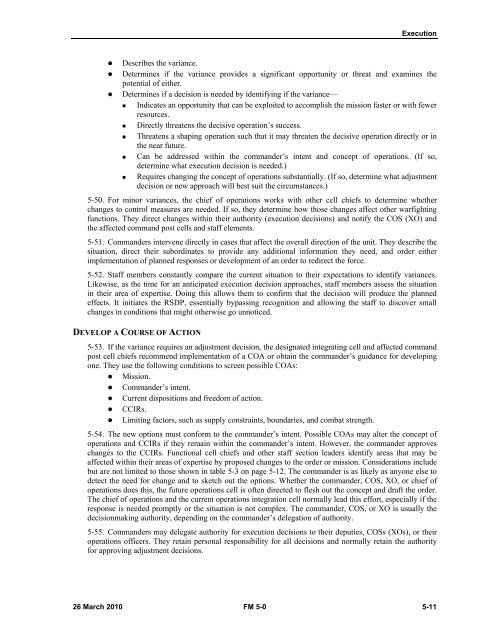FM 5-0, The Operations Process - Federation of American Scientists
FM 5-0, The Operations Process - Federation of American Scientists
FM 5-0, The Operations Process - Federation of American Scientists
You also want an ePaper? Increase the reach of your titles
YUMPU automatically turns print PDFs into web optimized ePapers that Google loves.
Execution<br />
• Describes the variance.<br />
• Determines if the variance provides a significant opportunity or threat and examines the<br />
potential <strong>of</strong> either.<br />
• Determines if a decision is needed by identifying if the variance—<br />
• Indicates an opportunity that can be exploited to accomplish the mission faster or with fewer<br />
resources.<br />
• Directly threatens the decisive operation’s success.<br />
• Threatens a shaping operation such that it may threaten the decisive operation directly or in<br />
the near future.<br />
• Can be addressed within the commander’s intent and concept <strong>of</strong> operations. (If so,<br />
determine what execution decision is needed.)<br />
• Requires changing the concept <strong>of</strong> operations substantially. (If so, determine what adjustment<br />
decision or new approach will best suit the circumstances.)<br />
5-50. For minor variances, the chief <strong>of</strong> operations works with other cell chiefs to determine whether<br />
changes to control measures are needed. If so, they determine how those changes affect other warfighting<br />
functions. <strong>The</strong>y direct changes within their authority (execution decisions) and notify the COS (XO) and<br />
the affected command post cells and staff elements.<br />
5-51. Commanders intervene directly in cases that affect the overall direction <strong>of</strong> the unit. <strong>The</strong>y describe the<br />
situation, direct their subordinates to provide any additional information they need, and order either<br />
implementation <strong>of</strong> planned responses or development <strong>of</strong> an order to redirect the force.<br />
5-52. Staff members constantly compare the current situation to their expectations to identify variances.<br />
Likewise, as the time for an anticipated execution decision approaches, staff members assess the situation<br />
in their area <strong>of</strong> expertise. Doing this allows them to confirm that the decision will produce the planned<br />
effects. It initiates the RSDP, essentially bypassing recognition and allowing the staff to discover small<br />
changes in conditions that might otherwise go unnoticed.<br />
DEVELOP A COURSE OF ACTION<br />
5-53. If the variance requires an adjustment decision, the designated integrating cell and affected command<br />
post cell chiefs recommend implementation <strong>of</strong> a COA or obtain the commander’s guidance for developing<br />
one. <strong>The</strong>y use the following conditions to screen possible COAs:<br />
• Mission.<br />
• Commander’s intent.<br />
• Current dispositions and freedom <strong>of</strong> action.<br />
• CCIRs.<br />
• Limiting factors, such as supply constraints, boundaries, and combat strength.<br />
5-54. <strong>The</strong> new options must conform to the commander’s intent. Possible COAs may alter the concept <strong>of</strong><br />
operations and CCIRs if they remain within the commander’s intent. However, the commander approves<br />
changes to the CCIRs. Functional cell chiefs and other staff section leaders identify areas that may be<br />
affected within their areas <strong>of</strong> expertise by proposed changes to the order or mission. Considerations include<br />
but are not limited to those shown in table 5-3 on page 5-12. <strong>The</strong> commander is as likely as anyone else to<br />
detect the need for change and to sketch out the options. Whether the commander, COS, XO, or chief <strong>of</strong><br />
operations does this, the future operations cell is <strong>of</strong>ten directed to flesh out the concept and draft the order.<br />
<strong>The</strong> chief <strong>of</strong> operations and the current operations integration cell normally lead this effort, especially if the<br />
response is needed promptly or the situation is not complex. <strong>The</strong> commander, COS, or XO is usually the<br />
decisionmaking authority, depending on the commander’s delegation <strong>of</strong> authority.<br />
5-55. Commanders may delegate authority for execution decisions to their deputies, COSs (XOs), or their<br />
operations <strong>of</strong>ficers. <strong>The</strong>y retain personal responsibility for all decisions and normally retain the authority<br />
for approving adjustment decisions.<br />
26 March 2010 <strong>FM</strong> 5-0 5-11















